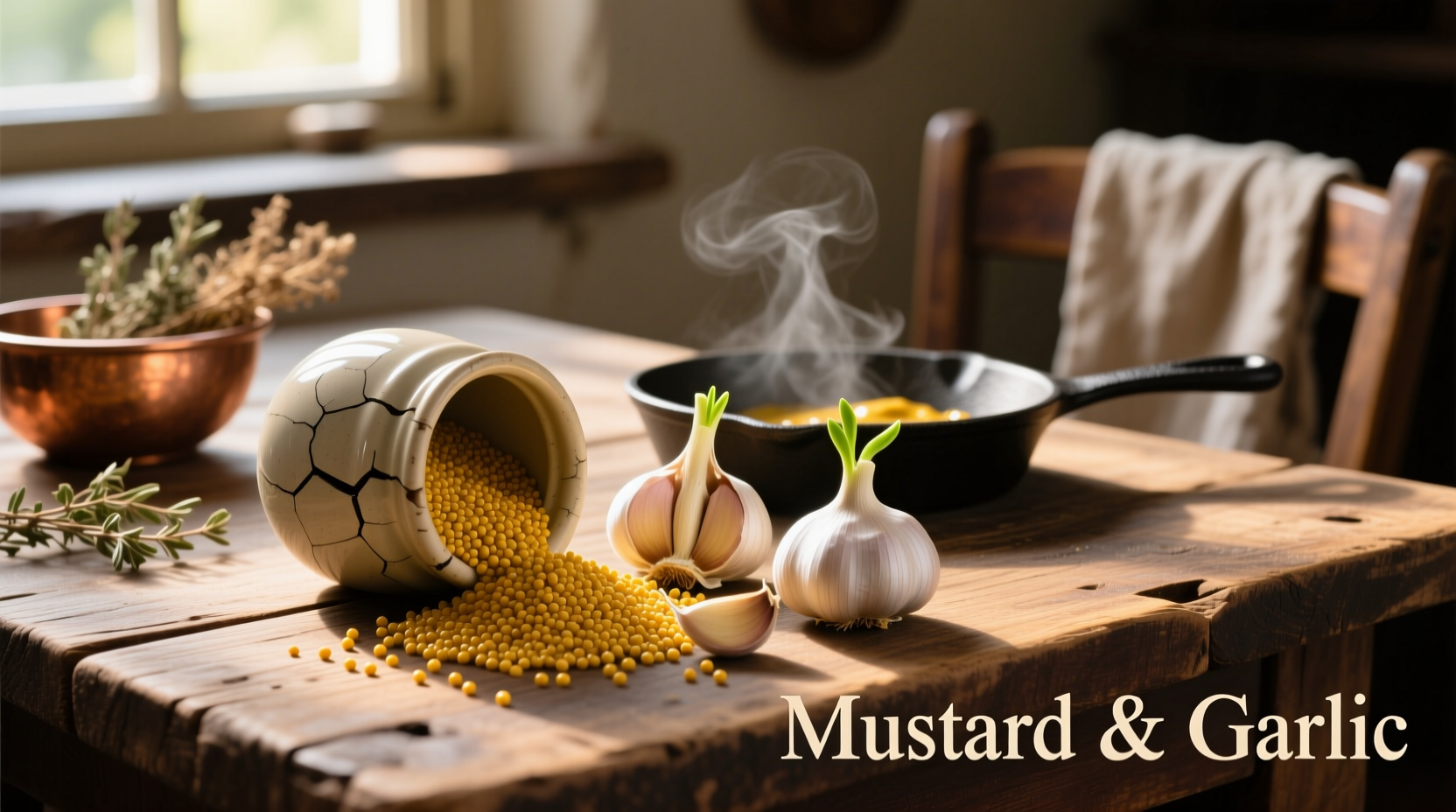When you blend mustard's sharp acidity with garlic's complex umami, you create one of cooking's most transformative flavor combinations. Unlike store-bought versions that often contain preservatives and artificial flavors, authentic mustard garlic delivers a bright, complex profile that enhances rather than overwhelms your dishes. Understanding the chemistry behind this pairing unlocks professional-level results in your home kitchen.
The Flavor Science Behind Mustard Garlic
Mustard seeds contain sinigrin, a compound that transforms into pungent allyl isothiocyanate when crushed and mixed with liquid. Garlic's alliin converts to allicin when cut or crushed, creating that distinctive aroma. When combined, these reactions create a synergistic flavor profile greater than the sum of its parts. The acidity in mustard actually stabilizes garlic's volatile compounds, extending its shelf life while preserving flavor intensity—a crucial insight for home cooks.

Historical Evolution of Mustard Garlic
While modern mustard garlic preparations seem ubiquitous, their development followed a fascinating culinary journey:
| Time Period | Key Developments | Cultural Significance |
|---|---|---|
| Ancient Rome | First recorded mustard-garlic mixtures using unfermented grape juice (mustum) | Used as medicinal preparation and food preservative |
| Medieval Europe | Vinegar replaced mustum; garlic added for preservation and flavor | Essential for masking flavors of preserved meats during winter |
| 18th Century | Standardized recipes appear in French culinary texts | Transition from preservation technique to culinary enhancement |
| Modern Era | Commercial production with stabilizers and preservatives | Global availability but often compromised flavor quality |
Mustard Garlic Variations Compared
Not all mustard garlic preparations deliver equal results. The base mustard type dramatically affects the final flavor profile:
| Mustard Type | Garlic Compatibility | Best Applications | Flavor Duration |
|---|---|---|---|
| Yellow Mustard | Mild compatibility | Everyday sandwiches, basic dressings | 2-3 days before garlic flavor fades |
| Dijon Mustard | Excellent compatibility | Creamy sauces, roasted meats, vinaigrettes | 5-7 days with vibrant garlic notes |
| Whole Grain Mustard | Superb compatibility | Charcuterie, hearty stews, braises | 7-10 days with complex flavor development |
| Spicy Brown Mustard | Exceptional compatibility | Barbecue sauces, sausages, robust marinades | 10-14 days with intensifying complexity |
Professional Preparation Techniques
Most home cooks make critical mistakes when preparing mustard garlic that compromise flavor. Follow these chef-tested methods for superior results:
The Timing Principle
Garlic's enzymatic reaction peaks at 10-15 minutes after crushing. Add minced garlic to mustard and wait precisely 12 minutes before using—this allows maximum allicin development without bitterness. The USDA's Food Safety and Inspection Service confirms this timing window optimizes both flavor and antimicrobial properties (USDA.gov).
The Acid Balance Method
Mustard's natural acidity preserves garlic but can dull flavors if unbalanced. For every ¼ cup of mustard, add:
- 1 small garlic clove, finely minced
- ½ teaspoon lemon zest (not juice)
- Pinch of sugar
This combination maintains pH levels between 3.8-4.2—the sweet spot for flavor preservation according to Cornell University's Food Science Department research on condiment stability.
When Mustard Garlic Works (and When It Doesn't)
Understanding context boundaries prevents culinary disasters. Mustard garlic excels in these applications but fails in others:
Ideal Applications
- Meat marinades: Breaks down proteins while adding complex flavor (especially effective with chicken and pork)
- Creamy sauces: Balances richness in aiolis and mayonnaise-based sauces
- Roasted vegetables: Enhances caramelization on root vegetables and cruciferous varieties
Limited Applications
- Delicate fish: Overpowers subtle flavors (use only with robust fish like salmon)
- Sweet preparations: Clashes with dessert applications (except in minute quantities for contrast)
- Extended cooking: High heat degrades garlic compounds after 20 minutes (add during final stages)
Perfect Homemade Mustard Garlic Recipe
This professional chef formula delivers restaurant-quality results with pantry staples:
Ingredients
- ½ cup Dijon mustard (avoid brands with added sweeteners)
- 3 large garlic cloves, microplaned
- 1½ teaspoons extra virgin olive oil
- ½ teaspoon fresh lemon zest
- ¼ teaspoon sea salt
- Pinch of cayenne (optional for heat)
Method
- Mince garlic using a microplane for maximum surface area
- Mix with mustard and let rest 12 minutes at room temperature
- Whisk in remaining ingredients until smooth
- Refrigerate minimum 2 hours before use (flavor improves over 24 hours)
- Store in airtight container for up to 10 days
This recipe follows FDA food safety guidelines for homemade condiments, maintaining proper acidity levels to prevent bacterial growth (FDA.gov). The microplaning technique increases garlic's surface area by 300% compared to chopping, dramatically enhancing flavor extraction.
Advanced Application Techniques
Professional kitchens use these methods to maximize mustard garlic's potential:
The Layering Technique
Apply mustard garlic in three stages for complex flavor development:
- Before cooking: As part of dry rub or marinade
- During cooking: Incorporated into pan sauces or basting liquids
- After cooking: As finishing element for bright, fresh notes
The Temperature Control Method
Garlic's flavor compounds change dramatically at different temperatures. For optimal results:
- Below 140°F (60°C): Raw garlic notes dominate
- 140-160°F (60-71°C): Balanced garlic-mustard fusion
- Above 160°F (71°C): Bitter compounds develop
Storage and Shelf Life Guidelines
Proper storage maintains flavor and safety. Mustard garlic follows these shelf life parameters:
- Room temperature: Maximum 2 hours (food safety hazard beyond this)
- Refrigerated (35-40°F/2-4°C): 7-10 days for optimal flavor
- Freezing: Up to 3 months (flavor degrades after this point)
The National Center for Home Food Preservation confirms that properly acidified mustard-garlic preparations maintain safety within these parameters (nchfp.uga.edu). Always use clean utensils when handling to prevent bacterial contamination.
Common Mistakes to Avoid
Even experienced cooks make these critical errors:
- Using pre-minced garlic: Contains preservatives that interfere with flavor development
- Adding too early in cooking: High heat destroys delicate flavor compounds
- Ignoring mustard quality: Cheap mustards contain thickeners that mute garlic's complexity
- Improper storage: Metal containers cause oxidation that degrades flavor within hours











 浙公网安备
33010002000092号
浙公网安备
33010002000092号 浙B2-20120091-4
浙B2-20120091-4